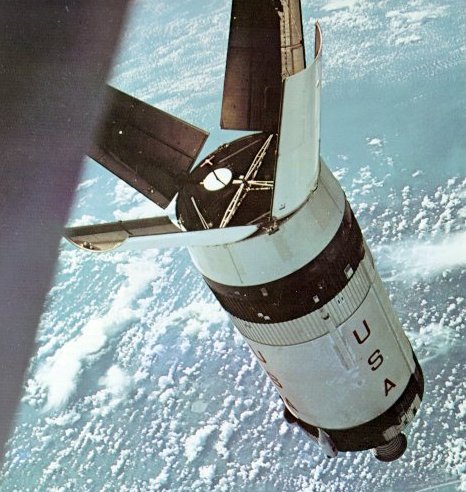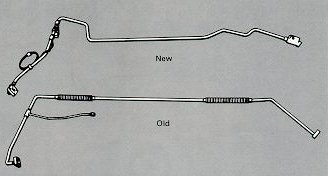
The Shakedown Cruises
By SAMUEL C. PHILLIPS

|
| Lifeless and slowly tumbling, the S-IB stage that put Apollo 7 in orbit gave Astronauts Schirra, Eisele, and Cunningham man's first ride atop a load of liquid hydrogen. Now the spent 59-foot stage served as a passive target for practice in rendezvous, with one run starting from a distance of 80 miles. |
Consider the mood of America as it approached the end of 1968, by any accounting one of the unhappiest years of the twentieth century. It was a year of riots, burning cities, sickening assassinations, universities forced to close their doors. In Southeast Asia the twelve-month toll of American dead rose 50 percent, to 15,000, and the cost of the war topped $25 billion. By mid-December the country's despair was reflected in the Associated Press's nationwide poll of editors, who chose as the two top stories of 1968 the slayings of Robert Kennedy and Martin Luther King; Time magazine picked a generic symbol, "The Dissenter", as its Man of the Year. The poll and the Man were scheduled for year-end publication.
This condition was changed dramatically during the waning days of the year, figuratively with two out in the last half of the ninth, and that is what this chapter is about.
Nineteen sixty-seven, which began as a bad year for the space program, had had its own sensational upturn with the first flight, unmanned, of the giant Saturn, on November 9 - a landmark on the path to the Moon. Then 1968 started fairly well with Apollo 5, the first flight of the lunar module on January 22, which proved the structural integrity and operating characteristics of the Moon lander, despite overly conservative computer programming that caused the descent propulsion system to shut off too soon.
The second unmanned Saturn V mission, numbered Apollo 6, on April 4, 1968, was less successful. For a time it raised fears that the Moon-landing schedule had suffered another major setback. Three serious flaws turned up. Two minutes and five seconds after launch the 363-foot Saturn V underwent a lengthwise oscillation, like the motion of a pogo stick. Pogo oscillation subjects the entire space-vehicle stack to stresses and strains that, under certain circumstances, can grow to a magnitude sufficient to damage or even destroy the vehicle. This motion, caused by a synchronization of engine thrust pulsations with natural vibration frequencies of the vehicle structure, tends to be self-amplifying as the structural oscillations disturb the flow of propellants and thus magnify the thrust pulsations.
The second anomaly, loss of structural panels from the lunar module adapter (the structural section that would house the lunar module), was originally thought to have been caused by the pogo oscillations. Engineers at Houston were able to establish, however, that a faulty manufacturing process was to blame. This was quickly corrected.

|
| A fiery exhaust plume trails Apollo 6 during the first stage of launch. Second-stage burn was marred by premature shutdown of three of the five J-2 engines, causing the craft to enter an elliptical rather than a circular orbit. Many months of technical detective work identified the bellows in one liquid hydrogen fuel line (bottom) as the culprit. In flight the bellows had flexed excessively, cracked, and leaked fuel. A redesigned fuel line substituted specially placed bends for the bellows. |

|
The third problem encountered on this flight was more serious. After the first stage had finished its work, the second stage was to take over and put Apollo 6 into orbit; then the third stage, the S-IVB, would take the CSM up to 13,800 miles, from where reentry from the Moon would be simulated, retesting the command module heat shield at the 25,000 mph that Apollo 4 had achieved five months earlier.
The second stage's five J-2 engines ignited as scheduled. About two-thirds of the way through their scheduled burn, no. 2 engine lost thrust and a detection system shut it down. No. 3 engine followed suit. With two-fifths of the second stage's million-pound thrust gone, Apollo 6, with the help of the single J-2 engine of the third stage, still achieved orbit, though in an egg-shaped path. But when the attempt was made to fire the third stage's engine a second time - as would be necessary to send astronauts into translunar trajectory - the single J-2 failed to ignite. The mission was saved when the service module's propulsion-system engine - 20,000 pounds of thrust as against the third stage's 225,000 - took over and sent the CSM up to the desired 13,800-mile altitude from which it reentered the atmosphere and landed in the Pacific.
| Next |